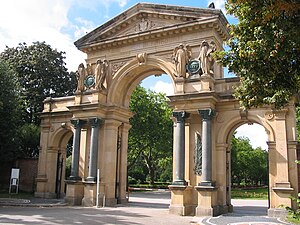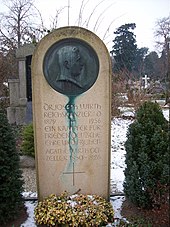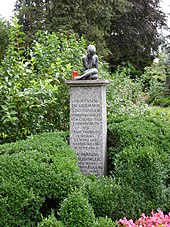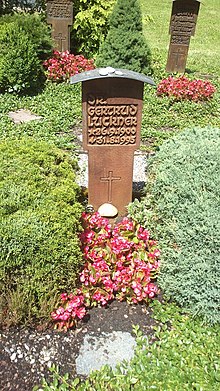Main cemetery Freiburg im Breisgau
The main cemetery in Freiburg im Breisgau was laid out in 1872. It covers an area of 27.11 hectares and is located in the south of the Brühl district .
history
The first general cemetery in Freiburg was on the north side of the Freiburg Minster . In 1515, at the instigation of Emperor Maximilian I, it had to be closed due to the risk of epidemics and relocated to St. Nikolauskirche in the suburb of Neuburg . This cemetery fell victim to the fortress construction by Vauban in 1678 . A few years later, today's Old Cemetery , a little further north, was inaugurated.
When, in the course of the rapid population growth of the city of Freiburg in the 19th century, this burial site no longer met the requirements, the New Cemetery , which at that time was still far from the city gates, was opened on November 1, 1872 . At that time it comprised today's grave fields 1–12, a mortuary and a crypt hall. Already in 1880 there was an extension to the grave fields 13-23 to the west. In the years 1894–99, the cemetery finally got its current size. During this time the new main portal and the consecration hall were built. In 1901 the grave chapel of the Mitscherlich family was built. In 1905 the private Magdalenenkapelle was completed by order of the dentist Karl Günther († 1894). It was created based on a design by Max Meckel in collaboration with the sculptors Johann Gastell (Schwaningen) and Joseph Dettlinger , the church painter Carl Schilling and the glass painter Falk. In 1914 the crematorium was opened .
Every year on Christmas Eve since 1927, a brass group has been playing Christmas carols in front of the consecration hall, to which numerous listeners come. The tradition was established when the Freiburg master bookbinder Max Rose died two days before Christmas in 1927. His widow Clara Rose decided to have a brass group play in the cemetery in his memory.
In the bombing of Freiburg on November 27, 1944, the old mortuary and crypt hall as well as the Magdalenenkapelle and numerous graves were destroyed, the consecration hall and Mitscherlichkapelle suffered damage.
In recent times, as a result of the changed sepulchral culture , the tombs in the western part have been gradually cleared and this partially converted into a forest field for tree burials.
Burial grounds
The oldest grave fields 1–23 were laid out in a conventional, rectangular grid. It was not until the major expansion from 1894 onwards that it was designed in the form of a park cemetery : the paths now ran radially without right-angled intersections, trees and bushes were planted as planned along the paths, and a small pond was created in the northern part. The grave fields 24–67 from that time are laid out in different shapes and sizes.
In addition to the general grave sites, there are some special grave fields:
Soldiers graves
The fallen soldiers of the two world wars who were buried in Freiburg are buried in five grave fields behind the consecration hall. After being damaged by aerial bombs in World War II , the fields were uniformly redesigned in 1956, with the individual grave marks being removed and replaced by name plaques.
Air raids victims

In front of the consecration hall there is a grave and memorial in which 1,664 victims of the air raid on November 27, 1944 are buried. The complex was initially characterized by individual grave complexes. A large wooden cross was erected for the first anniversary. The plan of then garden director Robert Schimpf to erect a single monumental memorial stone was not implemented. In 1954 there was an invitation to tender for an ideas competition. In 1956 the city council made the decision to implement the design based on a design by the garden architect Martin Zimber. The formulation of the text goes back to the Freiburg writer Reinhold Schneider . A memorial stone next to the grave and memorial commemorates the victims who were not recovered or buried. In the spring of 1958 the individually designed graves were cleared. The redesigned facility was inaugurated on November 27, 1958 by Mayor Josef Brandel . The complex also includes three granite crosses.
North of the consecration hall are on a grave field, which is dedicated to the dead of all air raids on Freiburg, including the victims of the mistaken bomb attack on Freiburg by German planes on May 10, 1940. In the middle of the grave field is a cross with a woman figure "The mourners" by Richard Engelmann . After long negotiations and deliberations on the design and location, the cross was inaugurated on October 18, 1951.
Burial ground 35
On grave field 35 are the children's graves, the anonymous urn graves and the graves of those who donated their corpses to the anatomical institute of the university .
Grove of Honor
In 2009, the newly designed honor grove was inaugurated on the base of the destroyed morgue on the south-east wall . Among other things, the tombstones of former honorary citizens are placed there.
buildings
New main portal
The eastern access to the main cemetery is a triumphal arch-like entrance gate with three passages. On both sides of the central main passage there are two angel figures with the attributes of mourning and hope, which bronze plaques with the key dates 1894 and 1899 hold the last cemetery expansion. The Reiselfinger- born sculptor Anton Viesel was involved in this portal .
Consecration hall
Inaugurated in 1899, the neo-renaissance- style consecration hall is a domed structure over the plan of a Greek cross with a height of 33 m. On one side is a wing with a morgue and functional rooms, the upper floor of which is the former apartment of the overseer.
crematorium
As early as February 1, 1894, the Citizens' Committee at that time approved the construction of a crematorium in a proposal for the new cemetery. But at this point there was no construction. Only after an increasing advocacy of cremation had developed in all important circles of society, the topic was brought back into political daily business in 1906. After a shortened discussion, the decision to build the crematorium was passed on November 6, 1912 with 56 votes to 52.
The Freiburg cremation association was founded on May 2, 1905 to promote the construction of the crematorium . In 1914, more than 470 members pursued the goal of building a crematorium and voluntary cremation. The crematorium was also approved by the Freiburg Social Democrats. According to the Social Democratic People's Watch on November 7th, 1912, the supporters also put forward that hygienic arguments, but also the smaller space requirement of urn graves, speak in favor of cremation.
The main argument of the opponents of cremation was that the body as the shell of the soul was a temple of God , according to the Freiburg messenger close to the center on October 31, 1912. The Catholic side in particular clearly rejected the new funeral rite . The Archbishop of Freiburg was even informed by the Holy Office on July 27, 1892 that a. It is forbidden to give the sacraments when they are burned . In the vote on the construction of the crematorium, the members of the Catholic Center Party voted unanimously against it. There were also fears that cremation might become mandatory. Another objection to the construction of the crematorium was that the construction and operation would be financed primarily from funds from the city of Freiburg. The opponents of cremation also criticized the higher price compared to an earth burial. This way of burial would only be possible for a wealthier part of the population. The fear expressed in other cities about uncertainties in the determination of death and the destruction of evidence were also taken up in the discussion about the construction of the crematorium.
The design of the crematorium was also a long struggle. None of the designs from an architectural competition from 1907/1908 were implemented. The construction of the crematorium finally took place under the direction of the city architect Rudolf Thoma and the city architect Mathias Stammnitz. The building was designed by the Freiburg construction company Brenzinger & Cie. Erected in reinforced concrete and clad with cast stone. The incinerator came from the Erfurt company JA Topf & Sons . The crematorium, built in the form of an ancient temple, went into operation on April 15, 1914. The first cremation was that of the body of the secret chief judicial officer Emil Huber.
Personalities
The following well-known people, among others, were buried in the main cemetery in Freiburg:
- Joseph von Buß (Franz Joseph Buß, from 1863 Ritter von Buß; 1803–1878), lawyer, constitutional law scholar and Catholic politician, court advisor to the Grand Ducal of Baden and professor at the University of Freiburg
- Joseph Bader (1805–1883), archivist and historian
- Michael Welte (1807–1880), inventor, music box maker and manufacturer
- Carl Mez (1808–1877), industrialist, Protestant social theologian and politician
- Adolf von Glümer (1814–1896), General
- Friedrich Michelis (1815–1886), Old Catholic theologian
- Eduard Fauler (1819–1882), entrepreneur and politician
- Franz Xaver Kraus (1840–1901), art and church historian
- Karl Binding (1841–1920), criminal lawyer
- Hermann Dimmler (1843–1903), pianist and conductor, pupil of Franz Liszt
- Otto Winterer (1846–1915), politician, Lord Mayor of the cities of Konstanz (1877–1888) and Freiburg (1888–1913)
- Julius Seitz (1847–1912), sculptor
- Max Meckel (1847–1910), architect
- Theodor Leutwein (1849–1921), commander of the Imperial Protection Force and governor of German South West Africa
- Otto Lenel (1849–1935), legal historian
- Ernst Thomas (1849–1905), pathologist
- Franz Baer (1850–1891), architect
- Paul Kraske (1851–1930), surgeon
- Max von Gallwitz (1852–1937), General
- Gustav Adolf Knittel (1852–1909), sculptor
- Constantin Fehrenbach (1852–1926), Imperial Chancellor 1920–1921
- Fritz Geiges (1853–1935), glass painter and artist
- Johannes von Kries (1853–1928), psychologist and physiologist
- Hans von Krafft-Ebing (1854–1930), Baden Oberamtmann
- Ferdinand Kopf (1857–1943) politician of the Center Party and honorary citizen of the city of Freiburg
- Lorenz Werthmann (1858–1921), Catholic priest and social politician
- Ernst Georg Kurz (1859–1937), doctor, social hygienist, medical officer and coroner
- Bernhard von Beck (1863–1930), surgeon
- Emil Gött (1864–1908), writer
- Hermann Herder (1864–1937), publisher
- Carl Christian Mez (1866–1944), botanist
- Ludwig Aschoff (1866–1942), pathologist
- Rudolf G. Binding (1867–1938), writer
- Willibald Nagel (1870–1911), physiologist
- Paul Uhlenhuth (1870–1957), bacteriologist and hygienist
- Johann Baptist Knebel (1871–1944), Catholic theologian
- Franz Geiler (1879–1948), trade unionist and politician
- Joseph Wirth (1879–1956), Reich Chancellor 1921–1922
- Heinrich Brenzinger (1879–1960), manufacturer
- Engelbert Krebs (1881–1950), Catholic theologian
- Karl Müller (1881–1955), botanist and oenologist
- Hermann Staudinger (1881–1965), chemist and Nobel Prize winner
- Alfred Kühn (1885–1968), zoologist and geneticist
- Leo Wohleb (1888–1955), politician
- Franz Philipp (1890–1972), composer
- Albert Dossenbach (1891–1917), fighter pilot and holder of the Pour le Mérite
- Hermann Eris Busse (1891–1947), local writer and folklorist
- Joseph Beeking (1891–1947), Catholic theologian and social politician
- Otto Fretter-Pico (1893–1966), Lieutenant General
- Josef Schelb (1894–1977), composer and pianist
- Erich Wewel (1894–1974), publisher
- Franz Büchner (1895–1991), pathologist
- Engelbert Zaschka (1895–1955), chief engineer, inventor and helicopter pioneer
- Ernst Sander (1898–1976), writer
- Gertrud Luckner (1900–1995), resistance fighter
- Hermann Kopf (1901–1991), politician
- Friedrich Stegmüller (1902–1981), Catholic theologian
- Kurt Hans Sommermeyer (1906–1969), radiologist, biophysicist
- Hans Bender (1907-1991), psychologist
- Eberhard Meckel (1907–1969), writer
- Eugen Keidel (1909–1991), Mayor of Freiburg from 1962 to 1982
- Karl Büchner (1910–1981), classical philologist
- Walter Nikolaus Schumacher (1913–2004), archaeologist
- Edith Picht-Axenfeld (1914–2001), pianist, harpsichordist and organist
- Leif Geiges (1915–1990), photographer and reporter
- Gerhard Dabel (1916–1984), writer and head of the Kinderlandverschickung service at the Reich Youth Leadership
- Rolf Böhme (1934–2019), 1982 to 2002 Lord Mayor of Freiburg
literature
- Charlotte Brass, Damaris Zanger: Triumph and Sorrow. The main cemetery. Main portal and consecration hall. and The work of art in the age of its electrical reproducibility. Electroplating in the main cemetery. In: Michael Klant (Ed.): Sculpture in Freiburg. 19th century art in public spaces. Freiburg 2000, ISBN 3-922675-77-8 , pp. 103-113.
- Joachim Faller: The Freiburg Crematorium and its Prehistory . In: Freiburger Diözesan-Archiv , 120th year 2000, pp. 249–260.
- Peter Kalchthaler : 125 years of the main cemetery, 1872–1997. History, art, architecture. Freiburg 1997.
- Ingeborg Inhoffen: Only language in stone. Impressions of the Freiburg main cemetery. Freiburg 1984, ISBN 3-89155-004-9 .
- Miriam Keller, Nadja Maruschka: Style pluralism around 1900. The main cemetery. In: Michael Klant (Ed.): Sculpture in Freiburg. 19th century art in public spaces. Freiburg 2000, ISBN 3-922675-77-8 , pp. 114–119.
- Ute Scherb: We get the monuments we deserve. Freiburg monuments in the 19th and 20th centuries. City archive Freiburg im Breisgau 2005, ISBN 3-923272-31-6 .
- Mathias Stammnitz: The new cemetery . In: Badischer Architecten- und Ingenieur-Verein (Ed.): Freiburg im Breisgau. The city and its buildings. HM Poppen & Sohn, Freiburg 1898, pp. 415-422.
- Gitta Reinhardt-Fehrenbach: "... I want my body to be consumed by fire, it should pass quickly in smoke and ashes ...". The Freiburg crematorium. In: Monument Preservation in Baden-Württemberg , 24th year 1995, issue 4, pp. 199–206. ( PDF; 7.6 MB )
Web links
Individual evidence
- ↑ Werner Wolf-Holzäpfel: The architect Max Meckel 1847-1910. Studies on the architecture and church building of historicism in Germany . Josef Fink, Lindenberg 2000, ISBN 3-933784-62-X , p. 262 f .
- ^ BZ editorial team: Traditional concert in the main cemetery. Badische Zeitung, December 22, 2017, accessed December 25, 2017 .
- ^ Freiburg: Bombs on the cemetery - badische-zeitung.de. Retrieved December 30, 2013 .
- ↑ Michael Klant: Forgotten sculptors. In: Sculpture in Freiburg. 19th century art in public space , Freiburg 2000, pp. 164–172 ISBN 3-922675-77-8 , p. 170
- ^ Freiburger Zeitung of May 17, 1914 [1] , accessed October 3, 2010
- ^ Local association Freiburg-Stühlinger eV (Ed.): Brenzinger & Cie. GmbH, concrete and reinforced concrete construction, cement goods factory. In: The Stühlinger. Festschrift for the 850th anniversary of the city of Freiburg im Breisgau. 1970, p. 83.
- ↑ See the company's advertising brochure in: Thüringisches Hauptstaatsarchiv Weimar, JA Topf & Sons No. 188, Bl. 70-74a.
- ^ Joachim Faller: The Freiburg crematorium and its prehistory. In: Freiburger Diözesan-Archiv , 120th volume (= 3rd episode, 52nd volume) 2000 , p. 259.
- ^ Joachim Röderer: Farewell to Rolf Böhme - a Homo Politicus and passionate European. Badische Zeitung, February 22, 2019, accessed on February 24, 2019 .
Coordinates: 48 ° 0 ′ 26.9 " N , 7 ° 50 ′ 41.8" E











